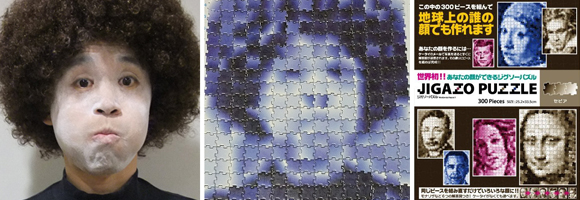
What can a puzzle that is not really a puzzle teach us about the future of product design? Actually, maybe a lot. The above image shows a Jigazo puzzle -- like so many things, only available in Japan -- which has been assembled to display the face of a child. This isn't anything special, since puzzles already are able to faithfully depict any face, or any other image, for that matter. What makes Jigazo unique is that its single set of pieces can be arranged to display any face. The company even offers the option to run your image through software which will generate build instructions for a unique puzzle. In fact, this un-puzzle is more like a paint-by-number: reconfigurable, generic parts which derive function through their structure. This shift in thinking will have far-reaching impacts as it continues to be applied to product design.
Generally, most consumers don't think about how the products they buy come to be. When they do, it is generally assumed that products are made in vertically integrated factories like Ford's River Rouge plant -- taking raw materials in one end, and spitting out toasters at the other. Indeed, various projects have undertaken to re-create this idealized manufacturing method on a personal level -- with amusing results.
But the truth is that modern manufacturing is less concerned with the substance of the car, and more with the structuring of the components within the car. In fact, auto manufacturing is a worldwide endeavor, often sourcing similar components for different cars in a line. In electronics manufacturing, the modularity is taken even further, to the point where any given device you choose probably contains at least one part in common with any other. Rather than focusing on mining the ores that go into a cellphone, Nokia simply sources parts from component vendors, who in turn source refined materials from silicon foundries, who in turn source their ores from giant mineral concerns. The benefits of such a system are numerous, but not the least of them is flexibility: a modular design eliminates the possibility for coercion by suppliers.
Of course, there are limits as well. As in the puzzle, this method works best within a limited domain. If the puzzle tried to depict snowy mountains rather than faces, the optimal balance of black, white, and gradient pieces would be thrown off, and designs would not be able to be rendered. This is the problem we face currently as designers who wish to more thoroughly hack our electronics. Current designs are like a puzzle which is capable only of the most minimal flexibility -- primarily due to unified board construction, and proprietary processor design. If these obstacles could be leveled; if cellphones, mp3 players, and cameras had more porous, flexible hardware and software, then the options of personal electronics might look as diverse as the many faces of the Jigazo.
|
0
comments
]








0 comments
Post a Comment